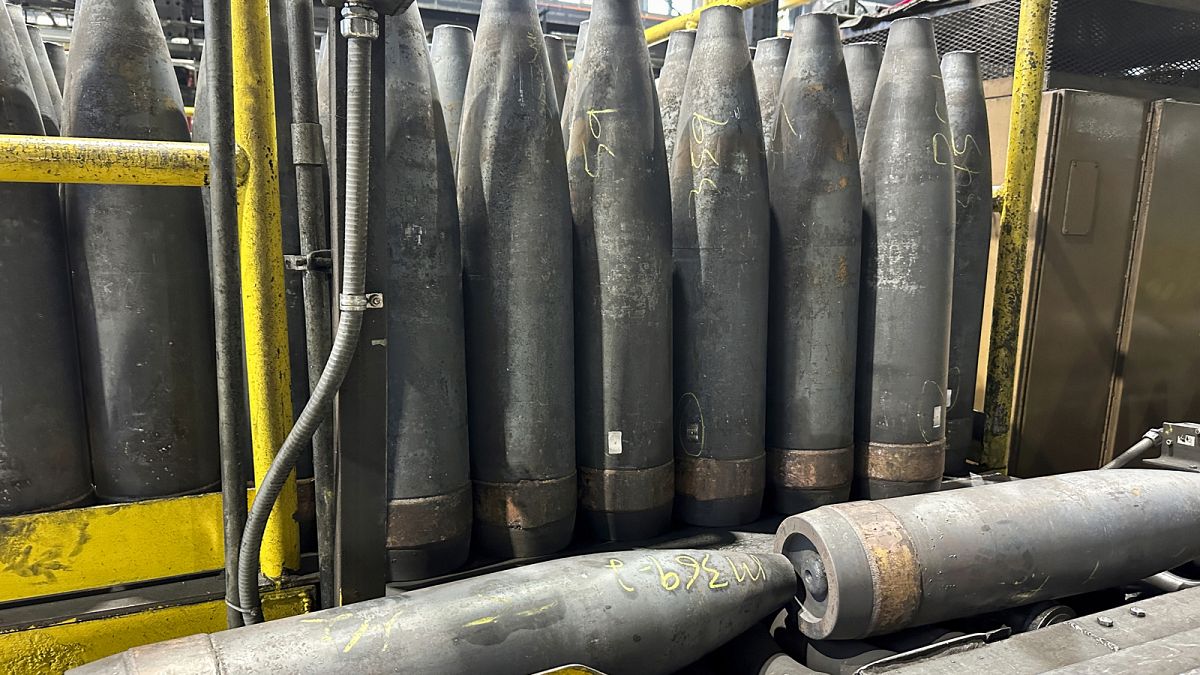In a keynote speech in London last month, the NATO Secretary General Mark Rutte repeated a warning he has made in public at least three times this year: the western alliance is severely lagging behind Moscow on ammunition production.
“In terms of ammunition, Russia produces in three months what the whole of NATO produces in a year,” Rutte said on 10 June, adding that Putin’s war machine is “speeding up, not slowing down”.
Rutte, who became chief of the military alliance in October last year, went on to repeat the same warning.
“Let me repeat it again. NATO’s economy is 25 times bigger than Russia’s. It’s 50 trillion (dollars), and the Russian economy is two trillion. That two-trillion-dollar economy is producing four times as much ammunition as the whole of NATO is producing at the moment,” he said.
We verified his claims against the available data. We found that, while Moscow’s ammunition production may have been approximately four times more than that of the NATO Alliance in 2024, there are signs that the gap could be closing.
What do we know about Russia’s ammunition production capacity?
Information about Moscow’s military production capacity is classified. Experts’ estimates are based on the statements of officials, leaked intelligence and historical data.
We can say with certainty that Moscow has steeply increased its ammunition production since it launched its full-scale invasion of Ukraine in 2022, outpacing its western counterparts.
The Estonian Foreign Intelligence Service estimates that Russia produced or refurbished 400,000 artillery rounds in 2022, multiplying its production more than eleven-fold to produce 4.5 million rounds in 2024.
An analysis by consulting firm Bain & Company for Sky News in May 2024 came to the same conclusion, putting the total number of shells produced or refurbished in 2024 at an estimated 4.5 million rounds.
Russia predominantly produces 122mm and 152mm artillery shells, while the NATO-standard shell has a slightly bigger diameter of 155mm, and is mainly used in the Western Howitzer systems, such as those provided by allies to Kyiv.
The Bain & Company analysis estimates that the 152mm shell favoured by Moscow is also around four times cheaper to produce at $1,000 (€860) per shell compared to $4,000 (€3430) for the NATO-standard 155mm shell.
The ammunition stockpile available to Moscow is also believed to be greater than its own production capacity due to the stocks it imports from its allies.
According to media reports citing South Korean intelligence leaked this week, North Korea has supplied Russia with 12 million rounds of 152mm shells to be used in Ukraine.
While this figure cannot be independently verified, satellite imagery analysed by the Wall Street Journal last December showed signs of a significant scaling up of production facilities in North Korea as well as an increase in shipments to Russia.
How does NATO’s capacity compare?
We verified Rutte’s statements by looking at the comparative ammunition production capacity of European allies and the US, the main NATO manufacturers.
In 2024, Europe and the US produced an estimated 1.2 million shells per year, according to the Berlin-based German Institute for International and Security Affairs, compared to Russia’s estimated 4.5 million.
These estimates would roughly align with Rutte’s claim that Russia is producing four times more ammunition annually than its NATO counterparts.
Yet the Western alliance is looking to dramatically close the gap in 2025.
The European Commission has set a target to ramp up ammunition production to 2 million rounds per year in 2025, while the US is looking to hit a new target of 100,000 rounds per month by October.
Other allies, including Norway, the United Kingdom and Canada, are also looking to boost supply chains.
While hitting those targets would see NATO significantly close the gap on Russia, western allies have in the past struggled to fulfil their promises.
The European Union missed its target to provide Ukraine with one million artillery shells by March last year, prompting the Czech Republic to spearhead an international fundraising drive to procure more ammunition rounds for Kyiv, which has since secured the participation of 16 countries.
The Czech initiative has since delivered 1.6 million shells to Ukraine. The Czech foreign minister said in May that funding has been secured to keep the programme going through to 2026, but that its future depends on parliamentary elections scheduled to take place in October.
Is the Western lag endangering Ukraine’s resistance?
It is also unclear how much of those Western stockpiles would be sent to Ukraine in 2025. The government in Kyiv has previously said it needs around 200,000 ammunition rounds per month to be able to withstand Russian assaults on the front line.
Ukrainian President Volodymyr Zelenskyy recently said that Ukraine hopes to receive some 3 million artillery shells from its allies this year, including 1.8 million from a Czech-led programme.
But the West, particularly Europe, is still struggling to fire up its ammunition industry. Explosives — the essential core of ammunition shells — are in shortage with just one single factory in Poland currently producing trinitrotoluene or TNT.
Western targets are also still far behind Russia’s, despite the Russian economy being almost 25 times smaller than the combined size of NATO’s economies.
Read the full article here


